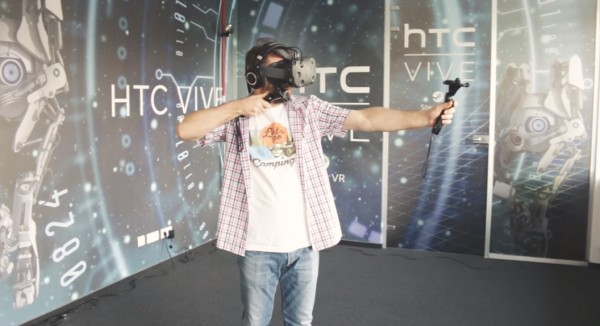One of the big problems Virtual Reality headset builders are currently trying to tackle is the sheer amount of cables involved. This is especially important for room-scale devices like the HTC Vive, which wants wearers to be moving around a room, rather than staying in one place. However, it looks like HTC/Valve may be close to tackling this already, as reports claim that a wireless Vive prototype is going to show up this Autumn.
Apparently Valve and Quark VR have been joining forces to put together a wireless HTC Vive prototype that could be revealed for the first time this year. According to Quark, they have managed to develop a small device that can hook up to the Vive, a transmitter can then be placed in the user's pocket, which will send and receive signals from the PC over WiFi.
One of the big issues so far has been reducing the connection delay, but Quark feels that they have almost narrowed it down to a point where a wireless Vive prototype could be shown off in public for the first time: “Getting the experience to feel seamless through Wi-Fi, keeping in mind the inevitable connection delay, was a huge challenge, but we’re getting extremely close to being able to show it in action!”
So perhaps we will end up with a wireless HTC Vive this time next year, eliminating the fear of tripping on a cable mid-game.
KitGuru Says: As an Oculus Rift owner myself, I haven't found the cable to be too distracting but then again, most of the Rift's games are seated. With the Vive and its room-scale tech, it makes perfect sense to invest in a wireless solution, after all, nobody wants to be worrying about tripping on their cable while walking around in a virtual world.
 KitGuru KitGuru.net – Tech News | Hardware News | Hardware Reviews | IOS | Mobile | Gaming | Graphics Cards
KitGuru KitGuru.net – Tech News | Hardware News | Hardware Reviews | IOS | Mobile | Gaming | Graphics Cards




I make roughly 6000-8000 bucks a month from freelancing at home. Those who are eager to work easy online tasks for some h a day at your home and make solid benefit while doing it… Then this work is for you… UR1.CA/pm79t
Why not to use Li-Fi ?
Because no one has it in their homes.
Given the price tag of the wired version. The wireless one will be nuts.
With no real AAA games to play……you have to love the hype
Considering the use of the base stations for vr position tracking, they could implement lifi into a base station connected to them.
It would be a better system in the end as on base station is always likely to have line of sight.
They need to move to Wigig. That has more than enough bandwidth to deal with all the data with no compression.
It’s not used and is a convoluted networking solution.
Google is paying 97$ per hour! Work for few hours and have longer with friends & family! !mj352d:
On tuesday I got a great new Land Rover Range Rover from having earned $8752 this last four weeks.. Its the most-financialy rewarding I’ve had.. It sounds unbelievable but you wont forgive yourself if you don’t check it
!mj352d:
➽➽
➽➽;➽➽ http://GoogleFinancialJobsCash352ShopDigitalGetPay$97Hour… ★★✫★★✫★★✫★★✫★★✫★★✫★★✫★★✫★★✫★★✫★★✫★★✫★★✫★★✫★★✫★★✫★★✫★★::::::!mj352d:….,…….
I currently get paid something like $6000-$8000 every month from working on the internet at home. For those of you who are considering to finish easy computer-based task for few hrs a day from your living room and gain decent benefit while doing it… Test this work UR1.CA/pm79t
Wigig is great, in theory, but even a piece of paper will reduce the signal significantly. It would have to rely heavily on reflection signals. Also, it is not even remotely available on the commercial market and it will probably be replaced by another [and better] technology by the time it becomes viable.
The attenuation is only due to low power. Mimo setups will solve that. Plus what “other” solutions have the bandwidth capable of delivering 2*4k resolutions (and this will increase)?
Seems like prudent to wait for the wireless Vive over the current one if this is indeed a prototype in advance development.